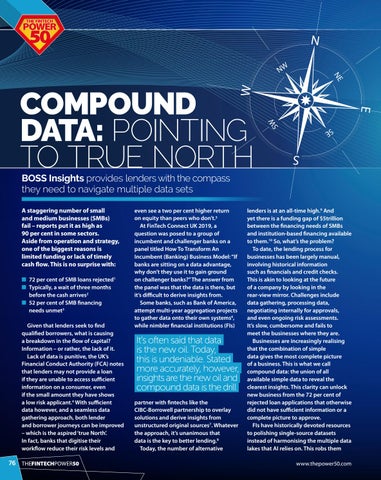COMPOUND DATA: POINTING TO TRUE NORTH BOSS Insights provides lenders with the compass they need to navigate multiple data sets A staggering number of small and medium businesses (SMBs) fail – reports put it as high as 90 per cent in some sectors. Aside from operation and strategy, one of the biggest reasons is limited funding or lack of timely cash flow. This is no surprise with: ■ 72 per cent of SMB loans rejected1 ■ Typically, a wait of three months before the cash arrives2 ■ 52 per cent of SMB financing needs unmet3 Given that lenders seek to find qualified borrowers, what is causing a breakdown in the flow of capital? Information – or rather, the lack of it. Lack of data is punitive, the UK’s Financial Conduct Authority (FCA) notes that lenders may not provide a loan if they are unable to access sufficient information on a consumer, even if the small amount they have shows a low risk applicant.4 With sufficient data however, and a seamless data gathering approach, both lender and borrower journeys can be improved – which is the aspired ‘true North’. In fact, banks that digitise their workflow reduce their risk levels and
76 THEFINTECHPOWER50
even see a two per cent higher return on equity than peers who don’t.5 At FinTech Connect UK 2019, a question was posed to a group of incumbent and challenger banks on a panel titled How To Transform An Incumbent (Banking) Business Model: “If banks are sitting on a data advantage, why don’t they use it to gain ground on challenger banks?” The answer from the panel was that the data is there, but it’s difficult to derive insights from. Some banks, such as Bank of America, attempt multi-year aggregation projects to gather data onto their own systems6, while nimbler financial institutions (FIs)
It’s often said that data is the new oil. Today, this is undeniable. Stated more accurately, however, insights are the new oil and compound data is the drill partner with fintechs like the CIBC-Borrowell partnership to overlay solutions and derive insights from unstructured original sources7. Whatever the approach, it’s unanimous that data is the key to better lending.8 Today, the number of alternative
lenders is at an all-time high.9 And yet there is a funding gap of $5trillion between the financing needs of SMBs and institution-based financing available to them.10 So, what’s the problem? To date, the lending process for businesses has been largely manual, involving historical information such as financials and credit checks. This is akin to looking at the future of a company by looking in the rear-view mirror. Challenges include data gathering, processing data, negotiating internally for approvals, and even ongoing risk assessments. It’s slow, cumbersome and fails to meet the businesses where they are. Businesses are increasingly realising that the combination of simple data gives the most complete picture of a business. This is what we call compound data: the union of all available simple data to reveal the clearest insights. This clarity can unlock new business from the 72 per cent of rejected loan applications that otherwise did not have sufficient information or a complete picture to approve. FIs have historically devoted resources to polishing single-source datasets instead of harmonising the multiple data lakes that AI relies on. This robs them www.thepower50.com
